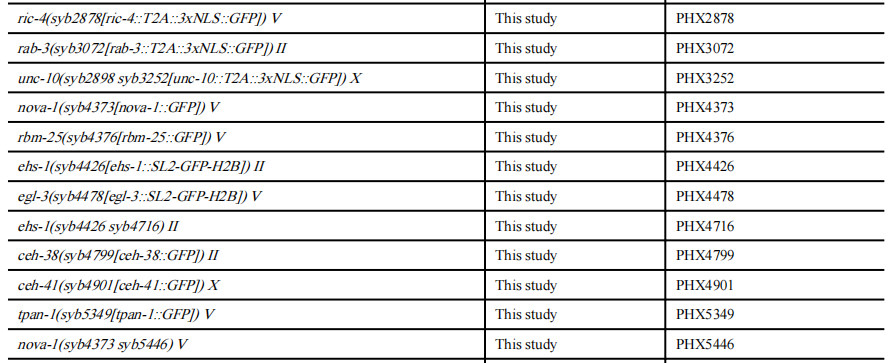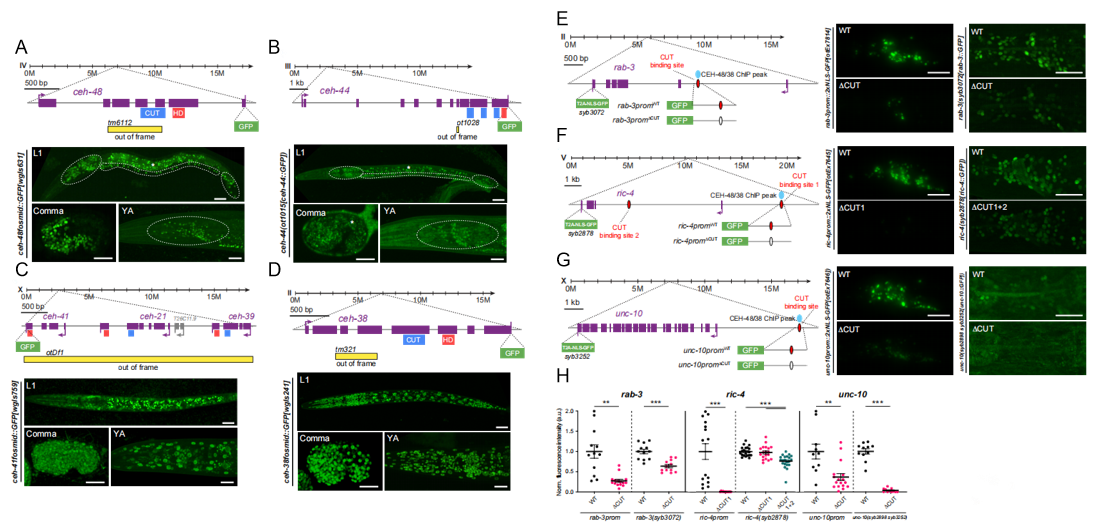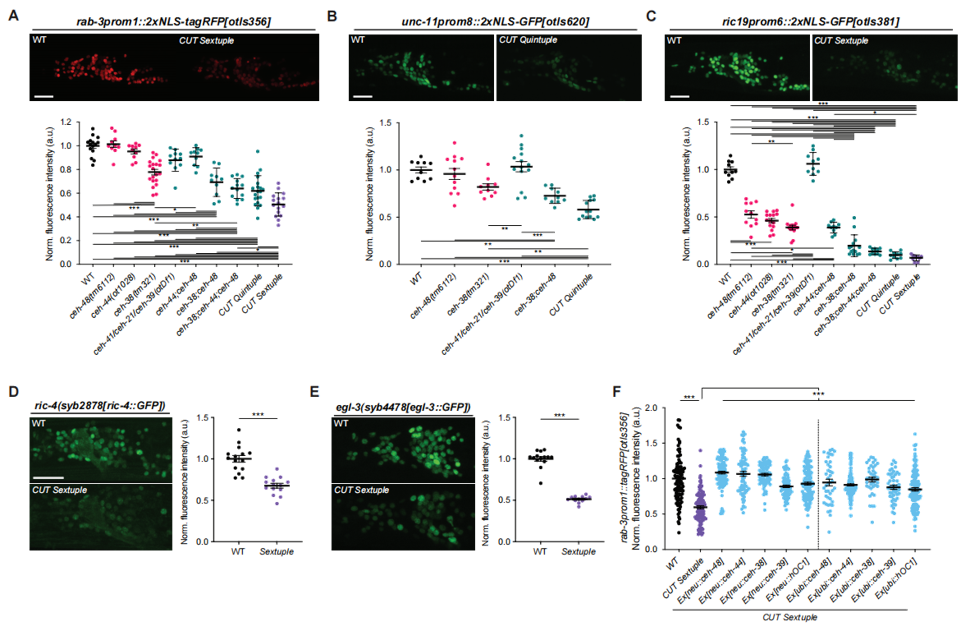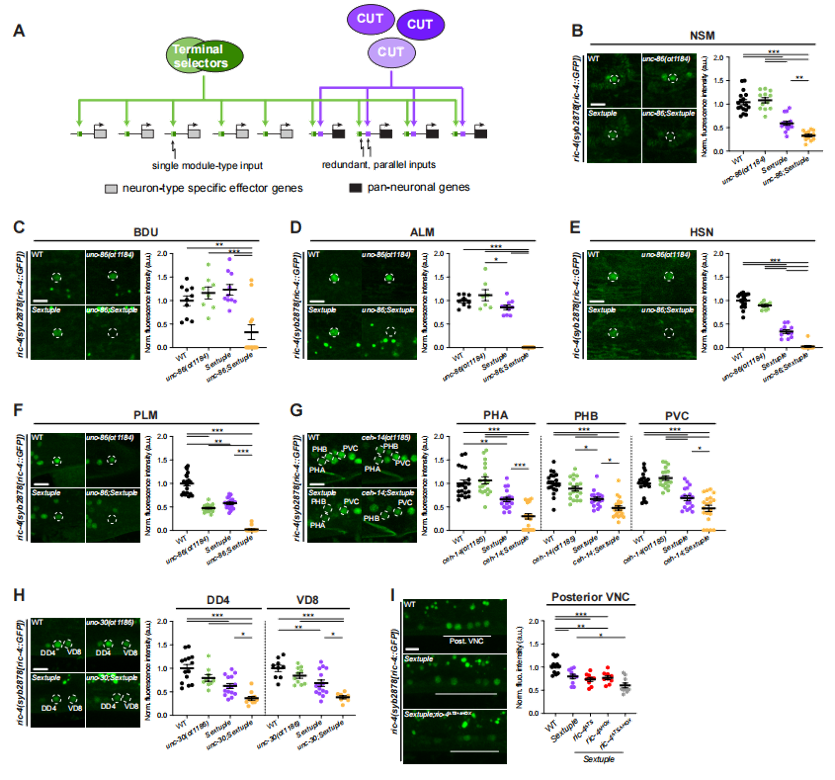The Role of CUT Homeobox Genes in C. elegans
2025-11-13 14:31
Keywords
Pan-neuronal gene expression, Neuronal regulation, Gene regulatory networks, Transcriptional control, Neurogenomics, Chromatin accessibility
Contribution of SunyBiotech
SunyBiotech is very honored to provide strain construction services for this study. Strains listed in the table were created for this work by SunyBiotech Corporation.

Introduction
In the development of the nervous system, it’s critical to understand how genes that govern neuronal function are regulated. Pan-neuronal genes, expressed in all neurons of an organism, control fundamental processes like synaptic vesicle release and neurotransmitter processing. While much has been known about how neuron-specific genes are regulated, the mechanisms behind pan-neuronal gene expression remained largely unexplored. Eduardo Leyva-Díaz and Oliver Hobert shed light on this question by focusing on a specific family of genes known as CUT homeobox genes, which play a crucial role in controlling pan-neuronal gene expression in C. elegans.
CUT homeobox genes are a family of transcription factors that are expressed in all neurons in C. elegans. These genes are essential for specifying pan-neuronal identity, meaning they help determine the features shared across all neurons, such as their ability to release neurotransmitters and process neuropeptides. The two key genes in this family, ceh-44 and ceh-48, are restricted to all neurons of the adult nervous system and regulate the expression of critical neuronal genes.
How Do CUT Genes Control Pan-Neuronal Genes?
Six members of the CUT homeobox gene family in C. elegans directly control pan-neuronal gene expression. Using CRISPR-Cas9 technology, researchers inserted a GFP reporter gene into an endogenous locus. Fluorescence imaging revealed that the CUT gene was expressed in all neurons and bound to the regulatory control regions of pan-neuronal genes (Figure 1A-D). Binding sites for CUT homeodomain proteins are required for pan-neuronal gene expression. The authors used two gene editing approaches, one to delete these binding sites using enhancer fragments isolated from the pan-neuronal locus, and the other to delete the CUT homeodomain binding sites at the endogenous locus of a pan-neuronal gene with GFP inserted into it using CRISPR-Cas9. Deletion of the CUT binding sites in both cases impaired pan-neuronal gene expression (Figure 1E-H). This suggests that the CUT transcription factor family may be a regulator of pan-neuronal gene expression.

Figure 1. The influence of the CUT homeobox gene family on the gene expression of pan-neurons
Appropriate CUT gene dosage ensures pan-neuronal gene expression.
Single CUT gene deletion mutations have little effect on pan-neuronal gene expression and the entire neuronal system. However, as more CUT family genes are knocked out, the function of the C. elegans nervous system is severely affected (Figure 2A-E). Nervous system anatomy revealed that functional defects are primarily manifested in synaptic transmission and synaptic density and CUT genes do not affect nervous system structure. Overexpression of a single CUT gene can rescue the phenotypes of mutants with multiple CUT gene defects to varying degrees (Figure 2F). These results indicate that CUT genes are functionally interchangeable, and that gene dosage, rather than the activity of specific family members, is the key factor determining the function of the CUT gene family.

Figure 2. Dose dependence of CUT gene expression in pan-neurons
Collaboration with Neuron-Specific Factors
The CUT genes do not work in isolation. The study also showed that they cooperate with other transcription factors, called terminal selectors, which specify neuron-type identities. Pan-neuronal genes contain terminal selector binding sites (Figure 3A). Although single-terminal selector deletion generally does not affect pan-neuronal gene expression, the incomplete loss of pan-neuronal expression in sextuple CUT mutants suggests that terminal selectors may provide redundant regulation of pan-neuronal gene expression, thereby contributing to the expression of the remaining pan-neuronal genes. Simultaneous deletion of all six CUT family members and different terminal selectors further reduced the expression of the corresponding pan-neuronal genes (Figures 3B-I). These terminal selectors ensure that pan-neuronal gene expression is maintained in neurons while also allowing for neuron-type specific gene expression. The combination of CUT genes and terminal selectors creates a highly integrated regulatory network that ensures the proper functioning of the nervous system.

Figure 3. CUT genes cooperate with terminal selectors to control pan-neuronal gene expression
Conclusion
By comparing the regulatory mechanisms in C. elegans to those in other species, the study suggests that the role of CUT genes in pan-neuronal gene expression may be a conserved feature in many organisms. Moreover, the dual regulatory strategies for pan-neuronal versus neuron-specific genes suggest that evolution has created a balance between stability and adaptability in the nervous system.
The discovery that CUT homeobox genes are critical regulators of pan-neuronal gene expression in C. elegans provides a much-needed piece of the puzzle in understanding how neurons maintain their shared functions. This research not only deepens our knowledge of gene regulation in the nervous system but also suggests potential avenues for future studies on how such mechanisms might operate in humans. By unveiling the complexity and robustness of these regulatory networks, we are one step closer to understanding the foundations of neuronal function and development. As research continues, these findings may also have profound implications for understanding neurological diseases and potential therapies.
Reference
Leyva-Díaz E, Hobert O. Robust regulatory architecture of pan-neuronal gene expression. Curr Biol. 2022;32(8):1715-1727.e8.
doi:10.1016/j.cub.2022.02.040






